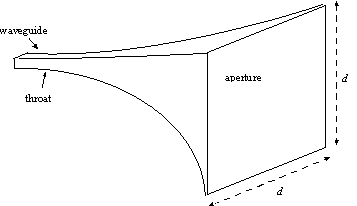Square Horn Antenna
The Square Horn Antenna Type uses an analytical model of a square horn antenna, including side lobes.

This antenna uses a polar coordinate system.
| Field | Description |
|---|---|
| Design Frequency |
This is the frequency of the antenna. The antenna design frequency is independent of the operational frequency of a transmitter, receiver, or radar. Changing the frequency of a transmitter, receiver, or radar does not update an embedded antenna's design frequency, nor vice versa. The design frequency is solely used at antenna configuration time to compute the antenna size from its max gain or beamwidth settings. A mismatch between signal frequency and antenna design frequency typically causes performance degradation. |
| Beamwidth | The beamwidth of the antenna gain pattern. Valid if Use Beamwidth is selected. The diameter and gain are automatically calculated on the basis of this value and the frequency. |
| Diameter | Diameter of the dish. Valid if Use Diameter is selected. The beamwidth and gain are automatically calculated on the basis of this value and the frequency. | Main-lobe Gain | The Main-lobe gain of the antenna gain pattern. Valid if Use Main-lobe gain is selected. The diameter and beamwidth are automatically calculated on the basis of this value and the frequency. |
| Efficiency | Specifies the efficiency factor of the dish, varying from 0 to 100 percent. Since no antenna is perfect, the efficiency factor allows you to specify the degradation in performance. Typical values fall in the range of 50 to 75 percent. |
| Back-lobe Gain | You can use back-lobe gain two different ways:
|